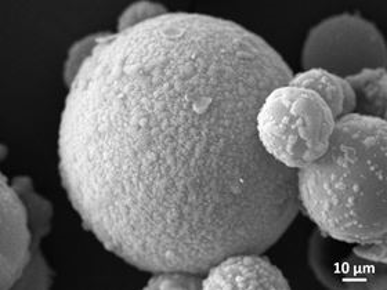Polymer composites with better electrothermal properties

The carbon nanofibers are synthesized by chemical vapor deposition to form a mixed filler covering the surface of the hollow glass microspheres. (courtesy of Roberto Guzman de Villoria)
At the same time , lightweight composite materials with high electrical conductivity and low thermal conductivity have an irreplaceable position in aerospace, marine and energy applications. They are the materials that engineers have dreamed of, but they are difficult in actual production. Researchers now believe that they can solve the problems encountered in the production of materials by filling hollow glass microspheres covered with carbon nanofibers into composite materials. [Research on carbon nanofiber-covered hollow glass microspheres can be found in Herrera-RamÃrezet al, Composites Science & Technology (2017), doi: 10.1016 /j.compscitech.2017.08.020. ]
Ps: Hollow glass microspheres are specially processed glass microspheres whose main feature is that the density is smaller than that of glass beads and the thermal conductivity is worse. It is a new micron-scale lightweight material developed in the 1950s and 1960s . Its main component is borosilicate . The general particle size is 10~250μm and the wall thickness is 1-2μm. The hollow glass microbeads have It has the characteristics of high compressive strength, high melting point, high electrical resistivity, small thermal conductivity and small thermal shrinkage coefficient. It is known as the "space age material" in the 21st century . Hollow glass microspheres have obvious weight reduction and sound insulation effects , which make the products have good crack resistance and reworkability. They are widely used in composite materials such as FRP, artificial marble and artificial agate, as well as petroleum industry and aerospace. New high-speed trains, automobile ships, thermal insulation coatings and other fields have effectively promoted the development of China's science and technology.
Hollow glass microbeads have become excellent polymer composite additives due to their light weight and low thermal conductivity. However, the strength of the composite material is reduced due to the low degree of interaction between the glass microspheres and the polymer matrix. Considering the excellent electrical conductivity of carbon nanotubes and carbon nanofibers, researchers have considered it as a filler for polymer composites. In order to get the proper balance performance, the researchers tried to integrate the optimal properties of these fillers.
Roberto Guzman de Villoria of the Spanish Composites Research and Development Application Center (FIDAMC) explained: "We intend to combine the low thermal conductivity of hollow glass microspheres with the high electrical conductivity of carbon nanofibers for use in thermal insulation in the aerospace industry. manufacture."
The team at the Spanish Composites R&D Application Center (FIDAMC) and the IMDEA Materials Research Institute not only simply added the two fillers to the polymer, but developed a new hybrid filler. The researchers chose hollow microspheres as the matrix of the filler. The microspheres ranged in size from 20-100 μm and were made of sodium-calcium-borosilicate glass. The surface was covered with carbon nanofibers (carbon nanofibers were chemically vapor deposited). The method is obtained), and the treated hollow microspheres are then embedded in a polymer matrix (urethane acrylate resin).
Guzman de Villoria pointed out: "By culturing carbon nanofibers directly on the surface of hollow glass microspheres, we avoid the complicated operation of dispersing nanofibers in the matrix, so that the cultured hollow microspheres can be directly used as standard fillers. use."
Researchers believe that the composite material developed is easy to process, lightweight, low thermal conductivity, and excellent electrical conductivity. It is a unique "characteristic polymer" for polymer matrix composites.
Guzman de Villoria said: "In the field of manufacturing where low thermal conductivity and high electrical conductivity are required, this material has great application prospects, for example in the field of thermoelectric devices that can only rely on expensive materials." Other applications may still Including electromagnetic interference materials commonly used in electronic equipment and insulation materials.
He added: "If we can develop composite materials with higher conductivity and lower thermal conductivity, then this material is used in lightning protection, electrostatic coating, electromagnetic shielding, thermal insulation, etc. Will be strongly sought after."
Researchers believe that their work can lay the foundation for the development of a new generation of mixed fillers, and promote the development of composites with new characteristics.
Ac Fan,Wireless Fan,Air Purifier Fan,Centrifugal Blower
Crown Electronics CO., LTD , https://www.crownelectronicstw.com
